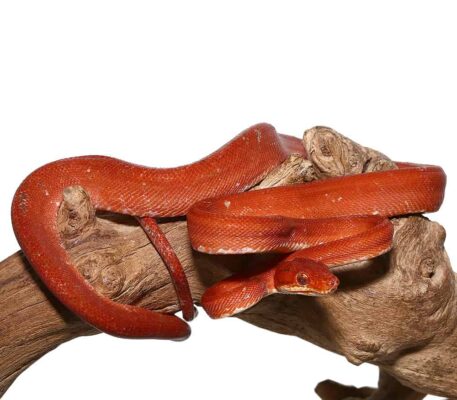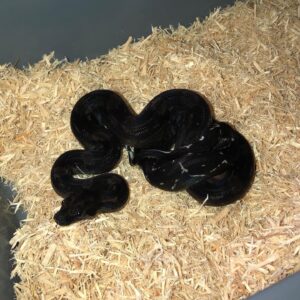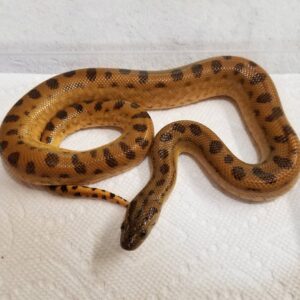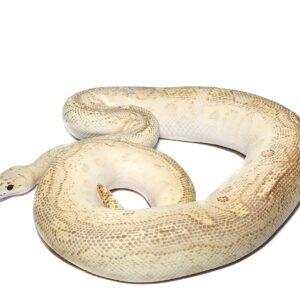Red Calico Amazon Tree Boa For Sale
$1,249.99
WE HAVE RED CALICO AMAZON TREE BOA AMAZON TREE BOAS FOR SALE. HERE ARE SOME HIGHLIGHTS:
- Corallus hortulanus
- Field Collected
- Female
- Approximately 3.5 Feet In Length
- Adults Will Grow Up To 4 – 6 Feet In Length From Head To Tail
- Feeding On Frozen Thawed Or Live Pinky Mice Weekly
FUN FACTS!
- Arboreal Species Requiring High Humidity And Daily Misting
- Originating From The Amazon, Ranging Central Venezuela, Eastern Colombia And Guyana
- This Species Is Known For Being Feisty But Is Easy To Handle With A Snake Hook
- With Proper Care And Set Up They Can Live Up To 12 – 20 Years In Captivity
Description
The Red Calico Amazon Tree Boa, scientifically known as Corallus hortulanus, is a captivating species that thrives in the dense rainforests of South America. Distinguished by its striking appearance, this boa showcases an array of vibrant colors that range from deep reds to intricate calico patterns, making it a subject of fascination for both herpetologists and reptile enthusiasts. The name “Red Calico” aptly describes its unique coloration, which often features a blend of red, orange, and white patches, resembling the calico pattern seen in certain breeds of domestic cats.
Adult Red Calico Amazon Tree Boas typically measure between 4 to 6 feet in length, with a slender, elongated body that is well-adapted to an arboreal lifestyle. Their prehensile tails and keeled scales assist in navigating the branches and foliage of their natural habitat. The boa’s head is notably large and triangular, equipped with heat-sensing pits that allow it to detect warm-blooded prey even in the dark, dense underbrush.
These boas are primarily found in the Amazon Basin, an extensive region that spans multiple South American countries including Brazil, Peru, and Colombia. The humid, tropical environment of the Amazon provides an ideal habitat, offering ample cover and a diverse range of prey. Despite their striking appearance, Red Calico Amazon Tree Boas are elusive creatures, often camouflaging themselves among the leaves and branches to avoid predators and ambush prey.
The Red Calico Amazon Tree Boa’s mesmerizing coloration and unique adaptations underscore the incredible biodiversity of the Amazon rainforest. Its presence highlights the intricate web of life that thrives in one of the world’s most vital ecosystems, making it an important species for ecological study and conservation efforts.
Natural Habitat and Distribution
The Red Calico Amazon Tree Boa, scientifically known as Corallus hortulanus, thrives in the lush and diverse ecosystem of the Amazon rainforest. This particular species of boa prefers habitats that provide ample humidity and consistent temperatures, essential factors for its survival and well-being. Typically found in regions where humidity levels range between 70% and 90%, the Red Calico Amazon Tree Boa is well-adapted to the rainforest’s moisture-laden environment.
Temperature is another crucial aspect of their habitat, with optimal conditions ranging from 75°F to 85°F (24°C to 29°C). These conditions facilitate proper thermoregulation, enabling the boa to maintain its physiological processes effectively. The dense vegetation of the rainforest, with its abundant trees and climbing structures, provides the perfect environment for this arboreal species. The tree boa exhibits remarkable agility and spends much of its time coiled around branches, where it can easily hunt for prey and avoid ground-dwelling predators.
Geographically, the Red Calico Amazon Tree Boa is predominantly distributed across the Amazon Basin, spanning multiple countries including Brazil, Peru, Ecuador, Colombia, and Bolivia. This extensive range underscores the species’ adaptability to various microhabitats within the vast rainforest. Additionally, these boas can occasionally be found in adjacent habitats such as secondary forests and riverine environments, where their needs for humidity and temperature are similarly met.
The Red Calico Amazon Tree Boa’s presence in these regions underscores the ecological richness of the Amazon and highlights the importance of rainforest conservation. By understanding the specific environmental conditions that support this species, conservationists can better focus efforts to preserve these critical habitats, ensuring the survival of the Red Calico Amazon Tree Boa and countless other species that call the Amazon their home.
Physical Characteristics and Behavior
The Red Calico Amazon Tree Boa is a captivating species, known for its striking physical characteristics and intriguing behaviors. This boa typically measures between 5 to 6 feet in length, exhibiting a slender and elongated body that enables nimble movement through its arboreal habitat. One of the most distinguishing features is its vibrant red calico pattern. This unique coloration, a blend of red, orange, and black patches, not only makes the Red Calico Amazon Tree Boa a visual marvel but also serves as effective camouflage amidst the dense foliage of the Amazon rainforest.
The scales of the Red Calico Amazon Tree Boa are smooth and glossy, contributing to its sleek appearance. This scale texture is particularly advantageous for climbing, as it reduces friction and allows the boa to navigate branches with ease. The boa’s prehensile tail further aids in its arboreal lifestyle, providing stability and grip as it traverses the treetops.
Behaviorally, the Red Calico Amazon Tree Boa is primarily nocturnal, becoming most active during the night. This nocturnal behavior aligns with its hunting strategy, as it preys on birds, small mammals, and lizards that are also active during these hours. The boa employs a sit-and-wait approach, relying on its excellent camouflage to remain undetected by both prey and predators. When a potential meal comes within striking range, the boa swiftly lunges and constricts its prey, utilizing its powerful muscles to subdue it.
In addition to its hunting prowess, the Red Calico Amazon Tree Boa is an adept climber. Its arboreal adaptations, including a flexible body and strong muscular structure, enable it to move effortlessly among the trees. This climbing ability is essential for accessing food sources and avoiding ground-based threats. Overall, the physical characteristics and behavior of the Red Calico Amazon Tree Boa are intricately adapted to its environment, making it a fascinating subject of study in the realm of herpetology.
Diet and Feeding Habits
The dietary preferences of the Red Calico Amazon Tree Boa are diverse, reflecting its adaptability to various prey types within its natural habitat. This arboreal serpent primarily sustains itself on a diet of small mammals, birds, and occasionally amphibians. These prey choices are driven by availability and the boa’s opportunistic foraging strategies, which allow it to thrive in the dense canopies of the Amazon rainforest.
When hunting, the Red Calico Amazon Tree Boa employs a sit-and-wait strategy, utilizing its exceptional camouflage to blend seamlessly into the foliage. It patiently awaits unsuspecting prey, striking with lightning speed when an opportunity presents itself. The boa’s keen sense of smell and heat-sensing pits aid in detecting nearby prey, even in the dimly lit environment of the forest understory.
Upon capturing its prey, the Red Calico Amazon Tree Boa relies on constriction to subdue its meal. This method involves wrapping its muscular body around the prey and applying pressure until the prey succumbs. Constriction is an efficient means of immobilization, ensuring that the boa can safely consume its meal without the risk of escape or injury.
Feeding frequency for this species varies depending on factors such as prey size, availability, and the boa’s own energy requirements. In general, these boas may feed every one to two weeks, although this can fluctuate based on the aforementioned factors. Juveniles tend to have a higher feeding frequency compared to adults due to their growth needs.
The Red Calico Amazon Tree Boa’s dietary habits not only highlight its role as a predator within the ecosystem but also underscore the importance of its adaptability. This adaptability ensures the species’ survival and contributes to the ecological balance within its habitat. Understanding these feeding habits provides valuable insights into the behavioral ecology of this fascinating serpent.
Reproduction and Lifespan
The reproductive cycle of the Red Calico Amazon Tree Boa is a captivating aspect of its biology. These boas exhibit a polygynous mating system, where males may mate with multiple females. Mating typically occurs during the rainy season, which is from November to March. During this period, males engage in competitive behaviors such as combat and scent-trailing to locate and court females. Courtship involves intricate behaviors including body alignment and the use of pheromones to stimulate the female.
Once mating has occurred, the gestation period for the Red Calico Amazon Tree Boa averages around 5 to 6 months. These boas are ovoviviparous, meaning that the females give birth to live young rather than laying eggs. A single reproductive event can result in a litter of anywhere from 10 to 25 neonates, with each offspring measuring approximately 12 to 16 inches in length at birth. The neonates are independent from birth, equipped with the necessary instincts and capabilities to survive in their environment.
The lifespan of the Red Calico Amazon Tree Boa varies significantly between wild and captive environments. In the wild, these boas face numerous challenges, including predation, disease, and habitat disturbances, which can limit their lifespan to around 10 to 15 years. However, when kept in captivity under optimal conditions, such as proper diet, habitat, and veterinary care, these boas can live significantly longer, often reaching up to 20 years or more. Captive boas benefit from the absence of natural predators and the presence of consistent care, which contributes to their extended lifespan.
Overall, the Red Calico Amazon Tree Boa’s reproductive behaviors and lifespan are shaped by both their natural habitat and human intervention. Understanding these aspects is crucial for the conservation and responsible care of this unique species.
Conservation Status and Threats
The Red Calico Amazon Tree Boa, scientifically known as Corallus hortulanus, is currently classified under the category of “Least Concern” by the International Union for Conservation of Nature (IUCN). Despite its relatively stable population, this species faces multiple threats that could impact its future survival. One of the primary threats is habitat destruction, particularly from deforestation in the Amazon Basin. The relentless clearing of forests for agriculture, logging, and urban development significantly reduces the natural habitats available for these arboreal reptiles.
Climate change poses another significant risk to the Red Calico Amazon Tree Boa. Alterations in temperature and precipitation patterns can disrupt their natural habitats, affecting the availability of prey and suitable nesting sites. Additionally, the changing climate can lead to an increase in extreme weather events, which may further threaten their survival.
The pet trade also represents a considerable threat to the Red Calico Amazon Tree Boa. Due to their striking appearance and relatively docile nature, these boas are highly sought after by exotic pet enthusiasts. Unfortunately, illegal collection and trade continue to pose a risk, despite various regulations aimed at curbing such activities.
Conservation efforts are being undertaken to protect this species and its habitat. Various organizations and local governments are working to enforce stricter regulations on deforestation and illegal wildlife trade. Protected areas and reserves have also been established to preserve critical habitats for the Red Calico Amazon Tree Boa and other wildlife. Additionally, education and awareness campaigns aim to inform the public about the importance of conserving these unique reptiles and their ecosystems.
Overall, while the Red Calico Amazon Tree Boa is not currently endangered, ongoing threats necessitate continued conservation efforts to ensure its long-term survival. By addressing habitat destruction, mitigating climate change impacts, and regulating the pet trade, we can safeguard this fascinating species for future generations.
Keeping Red Calico Amazon Tree Boas in Captivity
Maintaining Red Calico Amazon Tree Boas in captivity requires careful attention to their specific needs, ensuring a suitable environment that mimics their natural habitat. The enclosure should be spacious, with vertical space being a priority due to their arboreal nature. A tall terrarium, ideally measuring at least 3 feet in height, is recommended. Incorporate branches, perches, and foliage to provide climbing opportunities and hiding spots, which are crucial for the snake’s well-being.
Temperature and humidity control are paramount for the health of Red Calico Amazon Tree Boas. The enclosure should have a temperature gradient, with a basking spot maintained at 85-90°F and a cooler area around 75-80°F. Nighttime temperatures can drop slightly but should not fall below 70°F. Humidity levels should be kept between 60-80%, achievable through regular misting and the use of a substrate that retains moisture, such as coconut fiber or sphagnum moss. Monitoring these conditions with reliable thermometers and hygrometers is essential.
Feeding Red Calico Amazon Tree Boas involves offering appropriately sized prey, typically small rodents, every 10-14 days. Freshly killed or thawed frozen prey is preferred to live prey to avoid injuries to the snake. It’s crucial to observe feeding behavior and ensure the boa is eating regularly, as stress or improper conditions can lead to feeding issues.
Handling should be done with care and minimal frequency to reduce stress. Red Calico Amazon Tree Boas can be defensive, especially when young, and require gentle, confident handling. Over time, they may become more accustomed to interaction, but it is essential to respect their space and natural behaviors.
Potential challenges in keeping this species include maintaining the required environmental parameters and handling their sometimes unpredictable temperament. Ethical considerations should also be taken into account, such as sourcing captive-bred individuals to avoid contributing to the depletion of wild populations. Prospective owners must be committed to meeting these demands to ensure the welfare of their Red Calico Amazon Tree Boa.
Interesting Facts and Myths
The Red Calico Amazon Tree Boa, a captivating species native to the Amazon rainforest, has intrigued both herpetologists and enthusiasts alike with its distinctive coloration and arboreal lifestyle. One of the most fascinating aspects of this boa is its remarkable ability to change color. This phenomenon, known as color morphing, allows the snake to blend into its surroundings, providing an evolutionary advantage in avoiding predators and hunting prey.
Another intriguing fact about the Red Calico Amazon Tree Boa is its nocturnal behavior. These snakes are primarily active at night, using their keen senses and prehensile tails to navigate through the dense foliage of the Amazon canopy in search of food. Their diet mainly consists of small mammals, birds, and occasionally, other reptiles. Despite their predatory nature, these boas are known for their relatively calm demeanor when compared to other snake species, making them a popular choice among experienced reptile keepers.
Amid the interesting facts, several myths about the Red Calico Amazon Tree Boa persist. One common misconception is that these snakes are venomous. In reality, they are non-venomous constrictors, meaning they subdue their prey by coiling around it and applying pressure until it suffocates. Another myth is that they grow to enormous lengths. While they can reach a considerable size, typically between 5 to 7 feet, they do not attain the exaggerated proportions often depicted in folklore.
Herpetologists have shared numerous anecdotes about their encounters with the Red Calico Amazon Tree Boa. One notable story involves a biologist who observed a boa using its remarkable climbing skills to traverse a network of branches seamlessly. Such observations highlight the snake’s adaptability and the marvels of its natural habitat.
By dispelling myths and emphasizing the unique characteristics of the Red Calico Amazon Tree Boa, we gain a deeper appreciation for this extraordinary species. Understanding the true nature of these snakes not only enriches our knowledge but also fosters a greater respect for the biodiversity within the Amazon rainforest.







